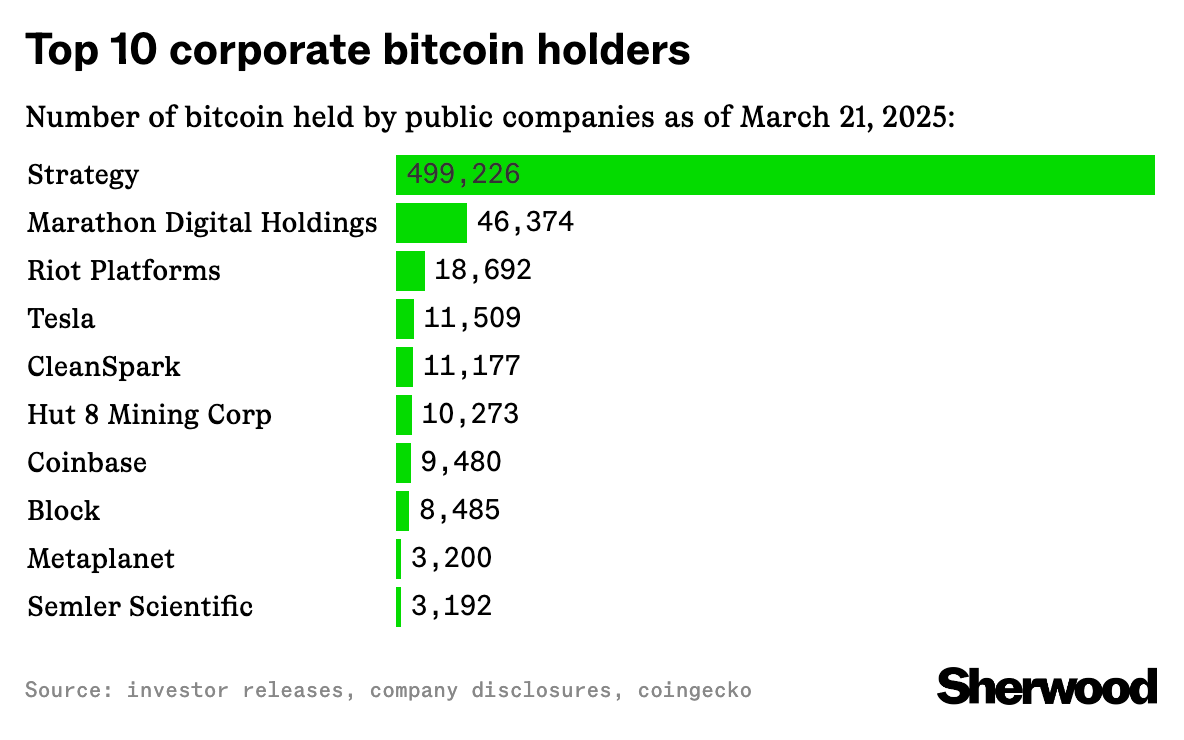Crypto's public market crossover
What's the trend of adding bitcoin to corporate treasuries say about the future of crypto?

Last week we talked about how crypto was facing a make-or-break moment. The core idea was whether or not crypto (or bitcoin more specifically) would decouple from plummeting public capital markets and demonstrate its utility as an alternative asset.
The conditions — set in motion by a steep ratcheting up of global trade tariffs by the Trump administration — created a near-perfect test to showcase bitcoin’s value at the macroeconomic level. But all of that already feels like last week’s news.
A global trade war, triggered by those tariffs, now seems to be on pause — at least partially, and perhaps temporarily.
Public markets bounced back on the announcement of the tariff pause. So did crypto markets. Where things go from here remains uncertain, given that tariffs as trade policy are only paused, not canceled.
But the market dynamics from last week made one thing clear: the global financial system is fragile and deeply interconnected. That fragility underscores the need for a decoupling mechanism — a kind of backup layer for the global economy.
Here’s how that volatile week played out in the price of bitcoin:

We’ve talked previously about the fear and greed index, which is also recovering quickly from last week’s lows.The context of corporate crypto and the continued financialization of everything
Historic market movements aside, another background trend continues to slowly, steadily advance: corporations adding bitcoin to their balance sheets.
The company Strategy (formerly MicroStrategy) has accumulated so much bitcoin that its risk profile made headlines as markets tumbled last week.
While Strategy gets most of the attention as a publicly traded company turned bitcoin bull, it’s not alone. Other corporations are also adopting bitcoin as a hedge of sorts.
Some of the companies in the graphic below will sound familiar. We already mentioned Strategy. Marathon, Riot, Hut 8, and CleanSpark are bitcoin mining companies, so holding bitcoin in their treasuries makes strategic sense. Coinbase and Block operate crypto exchanges and related services. Metaplanet is “Japan’s first and only publicly listed Bitcoin Treasury Company.” Tesla, a car company, and Semler Scientific, a healthcare tech firm, both began adding bitcoin to their balance sheets — Semler in mid-2024 — as a treasury strategy. Multiple articles about Semler’s pivot into digital assets highlight how the move has changed both their financial and marketing profile.

I’m bringing up the public market crypto crossover because it signals a broader trend — not just who is holding bitcoin, but how that bitcoin is being held. This shift is especially interesting when you consider BTC's increasing scarcity.
On one hand, increased institutional investment adds liquidity, which contributes to market stability. On the other, if more and more bitcoin ends up locked away in corporate treasuries (or government-controlled strategic reserves), it moves away from its original vision: an internet-native, peer-to-peer, cash-like crypto system.
In many ways, the financialization of crypto — especially bitcoin — really took off in 2024. It accelerated with the approval of the Bitcoin ETFs and, soon after, Ethereum ETFs. These products effectively lock crypto in institutional accounts, where brokerages and corporations are the primary holders, while retail investors are merely buying exposure — not the asset itself.
I’m bringing this up now because these trends — corporate control of crypto and the broader financialization of everything — are accelerating, in part due to the current administration’s crypto-friendly regulatory stance.
The trend of bitcoin treasuries may be good (albeit risky) for corporate balance sheets. But is it good for bitcoin and crypto more broadly? Does it signal mass adoption — or just treasury adoption? And does it help crypto decouple from global capital markets, or does it actually increase correlation by tying bitcoin more tightly to broader financial systems?
The answer is: nobody knows. It’s too early to tell. All of these dynamics are still in their early stages and building toward some kind of impact.
Open Money Project
I’m still working through the section of Open Money that focuses on real-world use cases. Personally, I find stablecoins to be one of the most compelling crypto use cases — if only because they stand in direct contrast to crypto’s often obnoxious, casino-like culture.
To me, stablecoins are designed to do two main things: maintain a consistent price and make moving money easier, more efficient, and more accessible.
What’s also interesting — and ties back to the intersection of capital markets and crypto — is that stablecoin issuers are now significant purchasers of U.S. Treasury notes, using those assets to maintain price stability.
Circle, the issuer of USDC and the second-largest stablecoin issuer by market cap, filed its S-1 this month and plans to go public soon — marking a major milestone in the evolution of stablecoins and the broader Open Money thesis.
Here are other recent Open Money posts:





